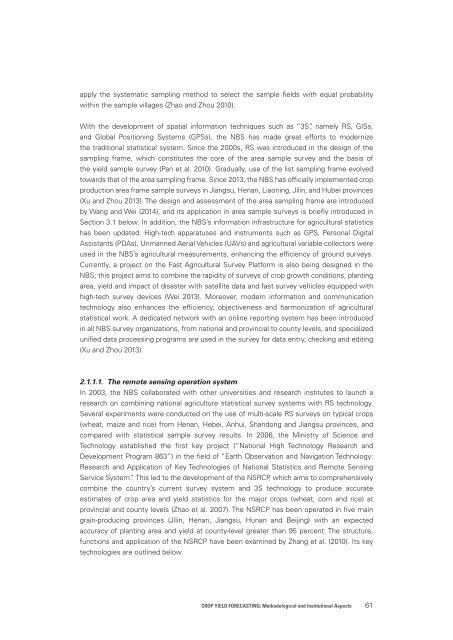Crop Yield Forecasting
1qKZxmS
1qKZxmS
Create successful ePaper yourself
Turn your PDF publications into a flip-book with our unique Google optimized e-Paper software.
apply the systematic sampling method to select the sample fields with equal probability<br />
within the sample villages (Zhao and Zhou 2010).<br />
With the development of spatial information techniques such as “3S”, namely RS, GISs,<br />
and Global Positioning Systems (GPSs), the NBS has made great efforts to modernize<br />
the traditional statistical system. Since the 2000s, RS was introduced in the design of the<br />
sampling frame, which constitutes the core of the area sample survey and the basis of<br />
the yield sample survey (Pan et al. 2010). Gradually, use of the list sampling frame evolved<br />
towards that of the area sampling frame. Since 2013, the NBS has officially implemented crop<br />
production area frame sample surveys in Jiangsu, Henan, Liaoning, Jilin, and Hubei provinces<br />
(Xu and Zhou 2013). The design and assessment of the area sampling frame are introduced<br />
by Wang and Wei (2014), and its application in area sample surveys is briefly introduced in<br />
Section 3.1 below. In addition, the NBS’s information infrastructure for agricultural statistics<br />
has been updated. High-tech apparatuses and instruments such as GPS, Personal Digital<br />
Assistants (PDAs), Unmanned Aerial Vehicles (UAVs) and agricultural variable collectors were<br />
used in the NBS’s agricultural measurements, enhancing the efficiency of ground surveys.<br />
Currently, a project on the Fast Agricultural Survey Platform is also being designed in the<br />
NBS; this project aims to combine the rapidity of surveys of crop growth conditions, planting<br />
area, yield and impact of disaster with satellite data and fast survey vehicles equipped with<br />
high-tech survey devices (Wei 2013). Moreover, modern information and communication<br />
technology also enhances the efficiency, objectiveness and harmonization of agricultural<br />
statistical work. A dedicated network with an online reporting system has been introduced<br />
in all NBS survey organizations, from national and provincial to county levels, and specialized<br />
unified data processing programs are used in the survey for data entry, checking and editing<br />
(Xu and Zhou 2013).<br />
2.1.1.1. The remote sensing operation system<br />
In 2003, the NBS collaborated with other universities and research institutes to launch a<br />
research on combining national agriculture statistical survey systems with RS technology.<br />
Several experiments were conducted on the use of multi-scale RS surveys on typical crops<br />
(wheat, maize and rice) from Henan, Hebei, Anhui, Shandong and Jiangsu provinces, and<br />
compared with statistical sample survey results. In 2006, the Ministry of Science and<br />
Technology established the first key project (“National High Technology Research and<br />
Development Program 863”) in the field of “Earth Observation and Navigation Technology:<br />
Research and Application of Key Technologies of National Statistics and Remote Sensing<br />
Service System”. This led to the development of the NSRCP, which aims to comprehensively<br />
combine the country’s current survey system and 3S technology to produce accurate<br />
estimates of crop area and yield statistics for the major crops (wheat, corn and rice) at<br />
provincial and county levels (Zhao et al. 2007). The NSRCP has been operated in five main<br />
grain-producing provinces (Jilin, Henan, Jiangsu, Hunan and Beijing) with an expected<br />
accuracy of planting area and yield at county-level greater than 95 percent. The structure,<br />
functions and application of the NSRCP have been examined by Zhang et al. (2010). Its key<br />
technologies are outlined below.<br />
<strong>Crop</strong> <strong>Yield</strong> <strong>Forecasting</strong>: Methodological and Institutional Aspects 61


